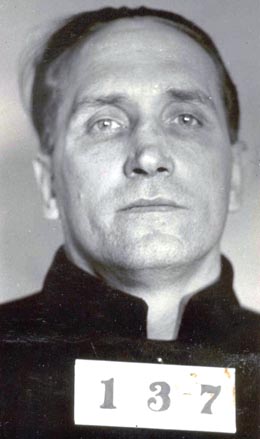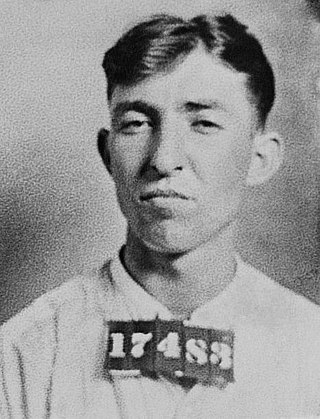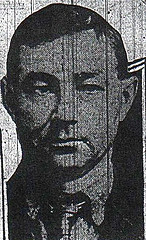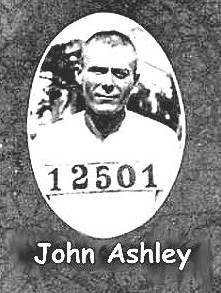
Kate Barker, better known as Ma Barker, was the mother of several American criminals who ran the Barker–Karpis Gang during the "public enemy era" when the exploits of gangs of criminals in the Midwestern United States gripped the American people and press. She traveled with her sons during their criminal careers.
The Fleagle Gang was a group of early 20th century American bank robbers and murderers. They were found and executed or killed after robbing the First National Bank in Lamar, Colorado. Their cases were the first in which the Federal Bureau of Investigation (FBI) used a single fingerprint as part of the evidence leading to a conviction. They were also suspected to have committed a series of previous bank robberies over a 10-year period.
Robert G. "Big Bob" Brady was an American bank robber and Depression-era outlaw. A well-known Oklahoma bandit during the 1920s and 1930s, Brady was associated with Wilbur Underhill, Harvey Bailey and Jim Clark.

Russell Lee "Boobie" Clark was an American thief, bank robber and prison escapee. He is best known as the "good natured" member of the John Dillinger gang and participated in armed holdups with them in a three-month crime spree across the Midwestern United States from October 1933 until his capture in January 1934.
Ed Davis was an American burglar, bank robber, and Depression-era outlaw. He was particularly active in Oklahoma, referred to by authorities as "The Fox", and frequently teamed with Jim Clark and Frank Sawyer during the early 1930s. Eventually captured in 1934, he was involved in a failed escape attempt from Folsom State Prison, resulting in the deaths of one guard and two inmates, and was executed at San Quentin.

Albert Lawrence Bates was an American bank robber and burglar during the 1920s and 1930s. He used a number of different aliases during his criminal career including George Davis, George Harris and J.B. King. He was the longtime partner of George "Machine Gun" Kelly. He also took part in the kidnapping of oil magnate Charles Urschel in July 1933.
Jim Clark was an American bank robber and Depression-era outlaw. A longtime career criminal in Oklahoma during the 1920s, Clark was associated with Wilbur Underhill, Harvey Bailey and Robert "Big Bob" Brady and remained a public enemy in the state of Kansas until his capture and imprisonment in 1934.
Lawrence DeVol was an American criminal, bank robber, prison escapee and Depression-era outlaw. He was connected to several Midwestern gangs during the 1920s and 1930s, most often with the Barker-Alvin Karpis and Holden-Keating Gangs, and was also a former partner of Harvey Bailey early in his criminal career. DeVol is known to have killed at least eleven people during his criminal career, including six law enforcement officers.

The Holden–Keating Gang was a bank robbing team, led by Thomas James Holden and Francis Lawrence Keating, which was active in the Midwestern United States from 1926 to 1932. Holden was described by a spokesman for the FBI as "a menace to every man, woman, and child in America" and was the first fugitive to be officially listed on the FBI's Top Ten Most Wanted List in 1950.

Adam "Eddie" Richetti was an American criminal and Depression-era bank robber. He was associated with Aussie Elliott and later Pretty Boy Floyd in the early-1930s, both he and Floyd later being implicated in the Kansas City Massacre in 1933.

Harold Eugene "Eddie" Green was an American bank robber and Depression-era outlaw during the 1930s, best known as a member of the John Dillinger gang. He was also associated with Frank "Jelly" Nash, Volney Davis and the Barker-Karpis Gang in his early career.

Herman Karl Lamm, known as Baron Lamm, was a German-American bank robber. A former Prussian Army soldier who immigrated to the United States, Lamm believed a heist required all the planning of a military operation. He pioneered the concepts of "casing" a bank and developing escape routes before conducting the robbery. Using a meticulous planning system called "The Lamm Technique", he conducted dozens of successful bank robberies from the end of World War I.

Henry Methvin was an American criminal, a bank robber, and a Depression-era outlaw. He is best remembered as the final member of Bonnie and Clyde's gang. His role in the gang has often been misattributed to teenage gang member W.D. Jones as both men were portrayed as composite character "C.W. Moss" in the film Bonnie and Clyde (1967).
The Kimes–Terrill Gang was a prohibition era bank robbing gang, led by Matthew Kimes and Ray Terrill, active in the Midwestern United States during the 1920s. The gang was known, not only for their high-profile robberies, but for their frequent escapes from prison. The members were alleged to have sworn a blood oath to free each other from jail, should they ever be captured, or die in the attempt.

John Hopkin Ashley was an American outlaw, bank robber, bootlegger, and occasional pirate active in southern Florida during the 1910s and 1920s. Between 1915 and 1924, the self-styled "King of the Everglades" or "Swamp Bandit" operated from various hideouts in the Florida Everglades. His gang robbed nearly $1 million from at least 40 banks while at the same time hijacking numerous shipments of illegal whiskey being smuggled into the state from the Bahamas. Indeed, Ashley's gang was so effective that rum-running on the Florida coast virtually ceased while the gang was active. His two-man raid on the West End in the Bahamas in 1924 marked the first time in over a century that American pirates had attacked a British Crown colony.
Wilbur Underhill Jr., often called "Mad Dog" or the "Tri-State Terror", was an American criminal, burglar, bank robber and Depression-era outlaw. He was one of the most wanted bandits in Oklahoma during the 1920s and 1930s and co-led a gang with Harvey Bailey that included many fellow Cookson Hills outlaws including Jim Clark, Ed Davis and Robert "Big Bob" Brady.
The Plymouth Mail robbery, or what the press dubbed "The Great Plymouth Mail Truck Robbery" was, at the time of its occurrence, the largest cash heist of all time. On August 14, 1962, two gunmen stopped a U.S. Mail truck that was delivering $1.5 million in small bills from Cape Cod to the Federal Reserve Bank in Boston, Massachusetts. The hijacking occurred on Route 3 in Plymouth, Massachusetts. The two robbers, dressed as police officers and brandishing submachine guns, tied up the driver of the truck and the guard and drove the truck themselves to places unknown, where the money was dropped off in several places. The truck and its two tied-up occupants were abandoned in Randolph, Massachusetts, alongside Route 128.

James "Old Jimmy" Hope was a 19th-century American burglar, bank robber and underworld figure in Philadelphia and later New York City. He was considered one of the most successful and sought after bank burglars in the United States during his lifetime as well as a skilled escape artist for his repeated breakouts from Auburn State Prison in New York.

The Barker–Karpis Gang was one of the longest-lived criminal gangs during the Depression Era, spanning from 1931 to 1935. The gang was founded by Fred Barker and Alvin Karpis, and later joined by Fred's brother Arthur "Doc" Barker. Along with the three core members, the gang's network spanned up to 25 members at one point.
The Hogan Gang was a St. Louis–based criminal organization that sold illegal liquor during Prohibition in addition to committing labor slugging, voter intimidation, armed robbery, and murder. Although predominantly Irish-American, the Hogan Gang included several Italian and Jewish mobsters amongst their ranks; most notably, Max "Big Maxie" Greenberg. They fought a notoriously violent gang war with Egan's Rats in the early 1920s.











